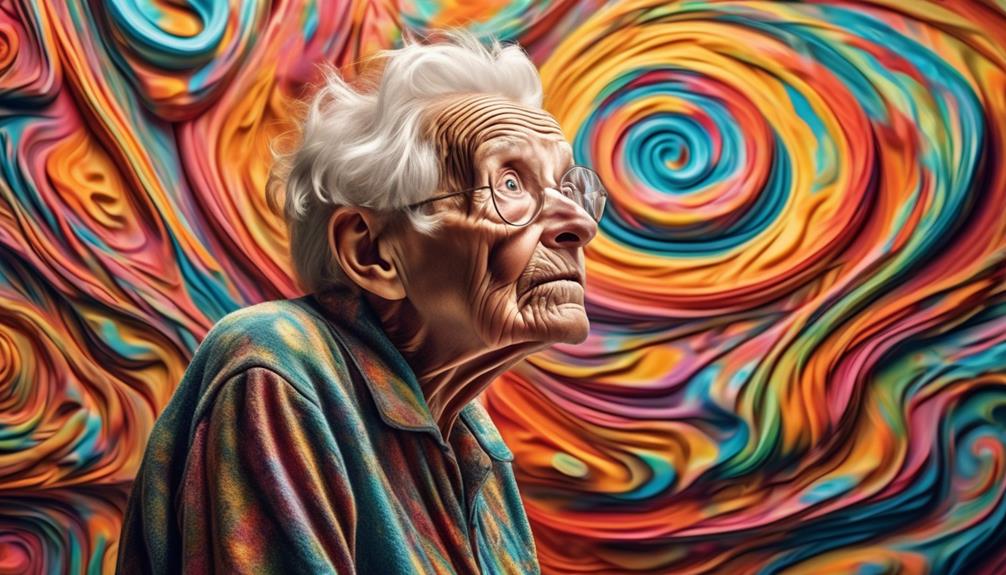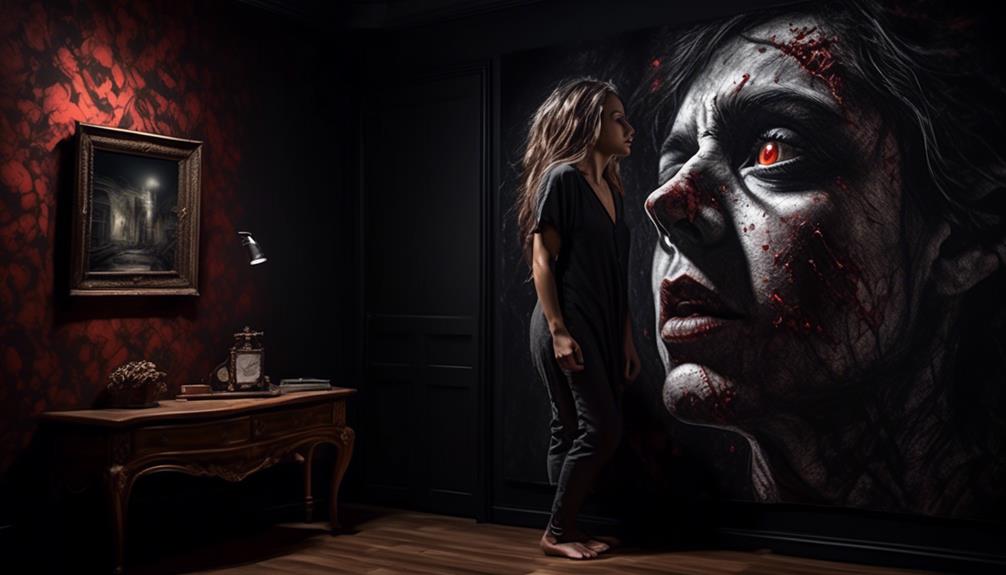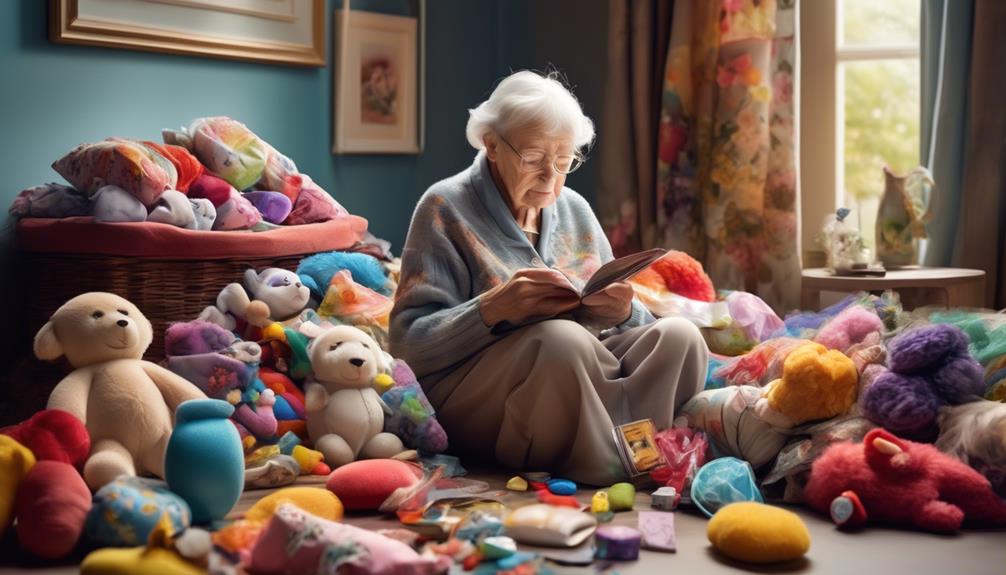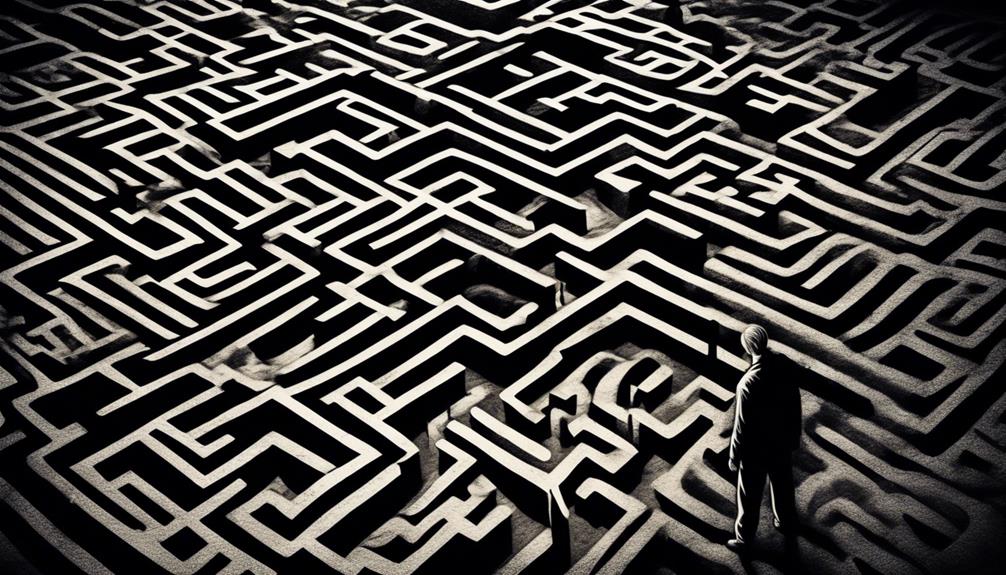When exploring the intricate world of dementia, we often come across a pivotal moment where the distinction between reality and hallucinations becomes blurred. Enjoy discovering the captivating mysteries of the mind as you embark on this distinctive journey. Keep following this intriguing path to enhance your understanding of the complexities of the human brain.
The question lingers in the air like a delicate whisper on a breeze – are hallucinations truly intertwined with the fabric of dementia?
Exploring this intersection reveals a complex interplay of cognitive decline, sensory distortions, and emotional nuances that beckon us to explore deeper into the mysteries that shroud this topic.
Key Takeaways
- Hallucinations in dementia can cause fear, confusion, and emotional distress.
- Visual hallucinations are the most common type experienced by individuals with dementia.
- Understanding the causes of hallucinations can help caregivers provide effective support and interventions.
- Creating a calm environment and engaging in soothing activities can help manage hallucinations.
Hallucinations in Dementia
In dementia, hallucinations can profoundly impact individuals by presenting false perceptions that feel intensely real, often causing fear, confusion, and emotional distress. People with dementia, especially those in the later stages of Alzheimer’s disease, may experience various types of hallucinations, with visual hallucinations being the most common. These hallucinations can involve seeing people, animals, or objects that aren’t there, hearing voices or sounds, or even feeling sensations like bugs crawling on the skin. While hallucinations can be frightening, it’s essential to comfort the person and respond with understanding and patience.
It’s crucial to seek medical evaluation to determine the possible causes of hallucinations in dementia. Sometimes, medications or other health issues can contribute to these symptoms. Understanding the individual’s experiences and providing a supportive environment can help manage hallucinations effectively. By acknowledging and addressing these false perceptions with compassion and empathy, caregivers and healthcare professionals can improve the quality of life for individuals living with dementia.
Types of Hallucinations

Visual hallucinations, auditory illusions, and tactile distortions are common types of hallucinations experienced by individuals with dementia. These sensory experiences can be distressing and confusing for the person with dementia and challenging for caregivers to manage. Here are some key types of hallucinations a person with dementia may experience:
- Visual Hallucinations: A person may see objects or events involving false perceptions, such as seeing people who aren’t there or misinterpreting shadows as threatening figures.
- Auditory Hallucinations: A person may hear sounds or voices that aren’t real, leading them to respond to nonexistent conversations or noises.
- Tactile Hallucinations: This type involves false sensations of touch or movement, like feeling insects crawling on the skin or experiencing a phantom touch.
Understanding these hallucinations can help caregivers empathize with the challenges faced by individuals with dementia and provide appropriate support and care.
Causes of Hallucinations
Experiencing hallucinations can be deeply distressing for individuals with dementia, and understanding the underlying causes is crucial in providing effective support and care. Hallucinations in dementia can manifest as frightening visions of people or false beliefs leading to significant distress. Several factors can contribute to the occurrence of hallucinations in older adults with dementia, including memory loss and side effects of medications. Below is a table outlining some common causes of hallucinations in individuals with dementia:
| Causes of Hallucinations | Description |
|---|---|
| Memory Loss | Disruption in memory processes can lead to misinterpretation of stimuli, resulting in hallucinations. |
| Medication Side Effects | Certain medications prescribed for dementia or other conditions may induce hallucinations as a side effect. |
| Sensory Deprivation | Lack of sensory input can cause the brain to create false ideas or perceptions, leading to hallucinations. |
| Psychosocial Factors | Emotional distress, loneliness, or environmental factors can trigger hallucinations in individuals with dementia. |
Understanding these potential causes can aid caregivers and healthcare professionals in providing tailored support and interventions to help manage hallucinations effectively in individuals with dementia.
Managing Hallucinations

Understanding the triggers and responses to hallucinations in individuals with dementia is essential for effective management and support. When a person with Alzheimer’s experiences hallucinations, it can be distressing for both the individual and their caregivers. It’s crucial to approach these situations with empathy and understanding.
Here are some tips from the Institute on Aging for managing hallucinations:
- Create a Calm Environment: Ensure the surroundings are peaceful and comforting to help reduce anxiety.
- Validate Their Feelings: Acknowledge the person’s emotions and reassure them that you’re there to help.
- Avoid Arguing: Refrain from trying to convince the person that what they see is false, as it’s real to the person experiencing it.
- Engage in Soothing Activities: Redirect their focus by engaging in calming activities like listening to music or going for a walk.
- Consult a Healthcare Professional: If hallucinations become frequent or distressing, seek guidance from a healthcare provider for additional support and strategies.
Improving Quality of Life

To enhance the well-being of individuals with dementia who may be experiencing distressing hallucinations, it is imperative to focus on improving their overall quality of life through tailored interventions and support strategies. People with Alzheimer’s disease often face challenges when they see or hear things that are not there. These hallucinations can be frightening and unsettling, leading to behaviors like accusing others of things they have not done or believing someone is taking their belongings. To address these issues and ensure the person is safe and feels secure, specific interventions can be implemented. One effective strategy is moving the individual to another room or environment where they may feel more at ease. It’s essential to understand that hallucinations can profoundly affect a person’s well-being and daily life. By providing targeted support and interventions, we can make significant strides in improving the quality of life for individuals struggling with hallucinations in dementia.
| Intervention Strategies | Benefits |
|---|---|
| Relocation to a new room | Creates a sense of safety |
| Cognitive-behavioral therapy | Helps manage distress |
| Encouraging physical activity | Promotes well-being |
| Establishing routine | Enhances predictability |
| Providing emotional support | Improves overall quality of life |
Frequently Asked Questions
What Stage Are Hallucinations in Dementia?
Hallucinations in dementia can manifest at various stages, impacting individuals differently. They may occur in early to advanced stages, often linked to specific types of dementia.
These experiences can be distressing, requiring tailored interventions. Understanding the stage when hallucinations arise is crucial for providing appropriate support and treatment. Hallucinations can manifest in various forms, including visual, auditory, or tactile sensations that may not be perceived by others. Recognizing the **types of hallucinations** a person is experiencing helps caregivers and healthcare professionals choose the best strategies for managing symptoms and improving quality of life. Early intervention may help minimize the distress these occurrences cause for both the individual and their loved ones.
What Is the Difference Between Hallucinations and Delusions in Dementia?
Hallucinations in dementia can be distressing for both individuals and caregivers. The difference between hallucinations and delusions lies in perception versus belief. While hallucinations involve incorrect sensory experiences, delusions are false convictions despite evidence.
Understanding this contrast can aid in tailored care approaches, such as creating a calming environment or seeking medical advice. Supporting individuals through these challenges with empathy and patience is crucial for their well-being.
What Kind of Dementia Causes Delusions?
Delusions can be a challenging aspect of dementia, often linked with conditions like Alzheimer’s disease. They can lead to distress and altered behaviors in individuals.
Understanding the underlying causes and seeking professional guidance are crucial steps in managing delusions effectively. By addressing these concerns with empathy and expert support, we can help enhance the quality of life for those experiencing dementia-related delusions.
How can we best support individuals navigating this difficult aspect of dementia?
How Do You Deal With Someone Who Is Hallucinating?
When dealing with someone who’s hallucinating, it’s important to stay calm and reassure them. Try to create a safe environment and gently redirect their focus.
Avoid arguing or dismissing their experiences. If the hallucinations are distressing or frequent, it may be helpful to consult with a healthcare professional for further guidance and support.
Conclusion
In conclusion, hallucinations are indeed part of dementia and can be distressing for those experiencing them.
By understanding the types and causes of hallucinations, we can better manage them and improve quality of life for individuals with dementia.
For example, Sarah, a woman with Alzheimer’s, finds comfort in listening to music when she experiences hallucinations, which helps to calm her mind and reduce anxiety.
It’s important to approach hallucinations with empathy and support to enhance overall well-being.









